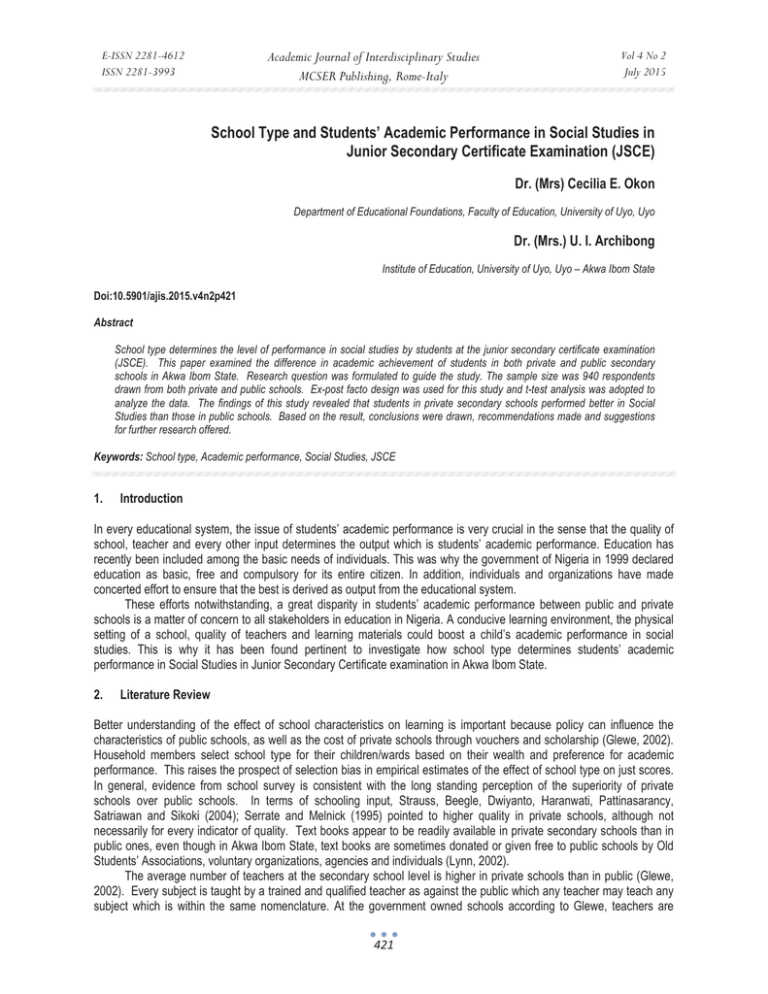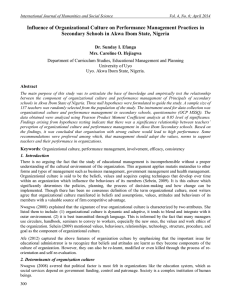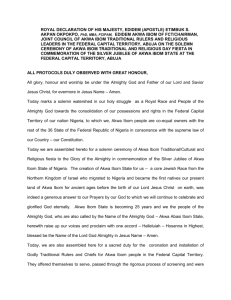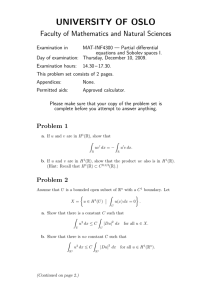School Type and Students’ Academic Performance in Social Studies in
advertisement

Academic Journal of Interdisciplinary Studies MCSER Publishing, Rome-Italy E-ISSN 2281-4612 ISSN 2281-3993 Vol 4 No 2 July 2015 School Type and Students’ Academic Performance in Social Studies in Junior Secondary Certificate Examination (JSCE) Dr. (Mrs) Cecilia E. Okon Department of Educational Foundations, Faculty of Education, University of Uyo, Uyo Dr. (Mrs.) U. I. Archibong Institute of Education, University of Uyo, Uyo – Akwa Ibom State Doi:10.5901/ajis.2015.v4n2p421 Abstract School type determines the level of performance in social studies by students at the junior secondary certificate examination (JSCE). This paper examined the difference in academic achievement of students in both private and public secondary schools in Akwa Ibom State. Research question was formulated to guide the study. The sample size was 940 respondents drawn from both private and public schools. Ex-post facto design was used for this study and t-test analysis was adopted to analyze the data. The findings of this study revealed that students in private secondary schools performed better in Social Studies than those in public schools. Based on the result, conclusions were drawn, recommendations made and suggestions for further research offered. Keywords: School type, Academic performance, Social Studies, JSCE 1. Introduction In every educational system, the issue of students’ academic performance is very crucial in the sense that the quality of school, teacher and every other input determines the output which is students’ academic performance. Education has recently been included among the basic needs of individuals. This was why the government of Nigeria in 1999 declared education as basic, free and compulsory for its entire citizen. In addition, individuals and organizations have made concerted effort to ensure that the best is derived as output from the educational system. These efforts notwithstanding, a great disparity in students’ academic performance between public and private schools is a matter of concern to all stakeholders in education in Nigeria. A conducive learning environment, the physical setting of a school, quality of teachers and learning materials could boost a child’s academic performance in social studies. This is why it has been found pertinent to investigate how school type determines students’ academic performance in Social Studies in Junior Secondary Certificate examination in Akwa Ibom State. 2. Literature Review Better understanding of the effect of school characteristics on learning is important because policy can influence the characteristics of public schools, as well as the cost of private schools through vouchers and scholarship (Glewe, 2002). Household members select school type for their children/wards based on their wealth and preference for academic performance. This raises the prospect of selection bias in empirical estimates of the effect of school type on just scores. In general, evidence from school survey is consistent with the long standing perception of the superiority of private schools over public schools. In terms of schooling input, Strauss, Beegle, Dwiyanto, Haranwati, Pattinasarancy, Satriawan and Sikoki (2004); Serrate and Melnick (1995) pointed to higher quality in private schools, although not necessarily for every indicator of quality. Text books appear to be readily available in private secondary schools than in public ones, even though in Akwa Ibom State, text books are sometimes donated or given free to public schools by Old Students’ Associations, voluntary organizations, agencies and individuals (Lynn, 2002). The average number of teachers at the secondary school level is higher in private schools than in public (Glewe, 2002). Every subject is taught by a trained and qualified teacher as against the public which any teacher may teach any subject which is within the same nomenclature. At the government owned schools according to Glewe, teachers are 421 E-ISSN 2281-4612 ISSN 2281-3993 Academic Journal of Interdisciplinary Studies MCSER Publishing, Rome-Italy Vol 4 No 2 July 2015 significantly more likely to have a second job, that is, some kind of trades. On the other hand, Galady and Thomas (2009) posited that teacher – student ratio in public schools are equal to or higher than the ratio in private secondary schools for the two levels of schooling – junior and senior. Junior secondary entrance fees paid by private schools were actually higher than the fees paid at government owned schools. School entrance/placement fees were abolished at public schools (Jasen, 2003). Moreover, the total school fees and other schooling costs, expenditure was higher for private schools than public schools. According to Fullarton (2002) overall past researches on school input concluded that along most dimensions, private schools used higher quality input because proprietors and proprietress did fancy spending money to acquire quality inputs. Whereas in government owned schools, the government is not ready to spend huge financial resources on education. Studies by Sexton (2001) and Stom (2003) on public and private schooling suggest that reform efforts and financial investments in the educational system should promote public schools implementation of policies and management ability. James, King, and Surgaha chi (2006) found that after controlling for existing test scores, public secondary schools included lower costs per student. They concluded that through effective management, improved academic quality can be achieved. Another research work by Bech and Gary (2010) claimed that students who schooled at private secular secondary schools enjoyed a wage premium of at most 75 percent over publicly schooled students. Private secular secondary schools provide a more valuable education than public secondary schools. Private schools look stronger on observable measures and are widely perceived as superior. Studies by Bedi and Grag (2002) supported that at the secondary level, private and public schools attract observable strong students. Private schools in urban areas screen the candidates for admission after completion of primary education. Therefore many private school students are selected for secondary education whereas public schools do not screen their candidates (Hexby, 2002; Somers, 2003). In Akwa Ibom State, the general impression people have is that private primary and secondary schools are meant for privileged people or class. Most of these private schools are well equipped, with basic amenities and attractions. They are also adequately staffed (Okon, 2013). Okon went further to assert that school environment determines the extent to which an individual student’s potential can be developed. The quality of the potential a student inherits from his/her parents and the condition of the school environment in which he is brought up jointly influence his learning and academic performance. Many public secondary schools are poorly structured, equipped, inadequately ventilated and decorated such that they are capable of eliciting deviant and disruptive behaviour that may influence teaching/learning, thus affecting academic performance. Schools that are poorly equipped and staffed may end up producing low achievers or may just produce average students. A stimulating school environment arouses the students to learn. Buder (2000) observed that a conducive school for learning includes: the physical environment of the school, the physical setting of the classrooms, teaching aids/materials and the quality of the teachers. The degree of interest a student has is derived from the learning environment which affects the academic performance. Akrafi (2001) agreed that well laid out grass lawn, flowers bed, graveled paths, playground and shady trees make students appreciative and this promote learning in many ways. Under shady trees, reading lesson, discussion on important academic issues and play activities among students can go on effectively. Akrafi further stressed that outside activities such as games, sports, club life and physical education are as important as the indoor classroom activities. Bernard (2005) found from a study of regional differences in intelligence test in Britain that children from the privileged group had higher mean scores than their counterparts from less privileged background. Bungress (2003) reviewed a number of studies carried out in the United States of America and confirmed that students from poor home background in the United States attained lower scores than privileged rich students in test of intelligences. In Akwa Ibom State, private – public secondary schools comparison is always an issue which needs urgent attention. In support of this assertion, in a study of the background of the children in three secondary schools in Western Nigeria, Bernard (2005) found that the selectivity index for secondary schools was 6.5 percent for students of professionals, executives and administrators, while for farmers, peasants and traders it was only 0.66 percent. In other words, when it comes to secondary school selection and placement of students for admission which is based on academic performance, children of professionals, executives and administrators are found to have an advantage over children of farmers, peasants, traders, and others. Studies have also pointed to a significant public school disadvantage, of fewer financial resources than private schools. Many public schools abound with comparatively inadequate or inappropriate training and less experienced teachers, poorly equipped laboratories/classrooms for instruction and inadequate access to computers and other learning facilities (Khatti, Killey & Kane, 2007). In Akwa Ibom State, education is free and compulsory, but there is no quality. There is a persistent view in political 422 E-ISSN 2281-4612 ISSN 2281-3993 Academic Journal of Interdisciplinary Studies MCSER Publishing, Rome-Italy Vol 4 No 2 July 2015 and policy-making circles, as well as among the general public that public schools provide inferior education. Students in public schools are often disadvantaged by poverty that restricts them from the opportunity to learn. Public schools often make do with the smaller per student budgets. Advanced subjects are less available in public schools, computer technology department may be poorly equipped if at all available (Okon, 2014). Ibia (2005) opined that in addition to educational materials supplied to schools, the school setting based on school type also influences teaching/learning of the students and hence the level of the students’ academic achievements. Thus, the specific type of school dictates what is taught, how it is taught and what materials are available. Ibia further maintained that where educative materials are deprived, students suffer from academic deterioration and mental imbalance. Also, where the teacher relates positively with the students, the school becomes conducive and learners perform well in their academic endeavours. An Akwa Ibom child attends either public or private school. The school setting affects his learning either positively or negatively. Ezearu (2003), Lynd and Lynd (2009), and Hallingshea (2009), found that there is a strong correlation between students’ social class and educational performance. This is because families do not attach the same amount of importance to teaching/learning process of their children in schools. Some well placed families motivate their children by exposing them to electronic media which increases the learner’s ideas about people and situations outside school hours. This helps in no small way in the learners’ knowledge of the current socio-political and economic issues. Khattri, Nidhi, Riley and Kane (2007) were of the opinion that background characteristics of the students and their families can also impact what the educational system can accomplish, while in turn these backgrounds characteristics are shaped by broader community pattern. Roscingno and Crouley (2012) left little doubt on their score of study. These researchers found that public secondary schools are disadvantaged in regard to those families and school resources which are conducive to educational success. They are disadvantaged by low human capital and core economic opportunity. Parents are unable to support their children’s education in private secondary schools. This unfortunate state of affairs is reinforced by public schools’ lack of resources. Young (2008) employed multi-level modeling to examine private and public schools’ differences in students’ achievement in science and science related areas. Young found a negative effect with public secondary schools only. This finding confirmed the fact that the achievement of students in public schools is lower than the achievement of students studying in private schools. It is against this background that this study is undertaken to investigate the influence of school type on students’ academic performance in social studies in Junior Secondary Certificate Examination (JSCE). 3. Purpose of the Study The purpose of this study was to examine the influence of school type on students’ academic performance in social studies in junior secondary three certificate examination in Uyo Local Government Area of Akwa Ibom State. 4. Research Question What is the difference in academic performance between social studies students who attend private secondary schools and those who attend public secondary schools? 5. Research Hypothesis There is no significant difference in academic performance between students who attend private secondary schools and those who attend public secondary schools. 6. Methodology The study adopted ex-post factor design. It is a systematic enquiry in which the researchers have no direct control over the independent variable because its manifestations had already occurred. With this design, questionnaire was used to collect data from the respondents to test the hypothesis developed for this study. The independent variable in the study was school type while the dependent variable was students’ academic performance in social studies. These variables were not manipulated by the researchers rather; the impact of the independent variable upon the dependent variable was studied. 423 Academic Journal of Interdisciplinary Studies MCSER Publishing, Rome-Italy E-ISSN 2281-4612 ISSN 2281-3993 7. Vol 4 No 2 July 2015 Population of the Study The population of the study consisted of all the 1032 and 2064 junior secondary three (JSS3) social studies students in public and private schools respectively, in Uyo Local Government Area in the 2013/2014 Academic Session (Akwa Ibom State Secondary School Board, 2014). 8. Sample and Sampling Technique The sample size was 940 social studies students. This comprised 470 students drawn from private schools and 470 from public secondary schools. The technique for sampling chosen was stratified and simple random sampling techniques. Out of the 14 public secondary schools in Uyo Local Government Area, 10 were selected using stratified random sampling technique. Also, out of the 16 private schools, 10 were used. A total number of 20 schools picked represented both the public and private secondary schools. The study was basically for JSS3 social studies students. 9. Instrumentation The first instrument for this study was school type questionnaire (STQ). It contained such test items as name of school, type of school, examination number, parents’ level of income, parents’ highest educational attainment/qualification, and so on. There were twelve items in all. This questionnaire was necessary for eliciting information from the respondents based on themselves as well as their home backgrounds. This 12- item researchers made questionnaire was used to collect data for the study. The instrument was validated by three experts in Test and Evaluation unit of the Department of Educational Foundations from the University of Uyo. Cronbach’s Alpha was used to determine the internal consistency at co-efficient of 0.79. Eighty copies of the questionnaire were distributed to the respondents at each sampled school with the help of two research assistants who were postgraduate students. Thirty minutes were given to the subjects to complete the questionnaire. All the copies were properly filled and returned. The data collected were thereafter analysed. The second instrument was the 2013/2014 junior secondary three institutionalized examination, set and marked by the Akwa Ibom State Ministry of Education (Examination Unit). The examination results of the respondents were obtained from the said Ministry. With the help of examination numbers supplied by the respondents, the researchers were able to locate the scores and grades of the participants. However, the bench mark for consideration as pass grades was 50 percent – 100 percent, while 0 – 49 percent was considered as fail. At the end of the exercise a total of 567 respondents from private secondary schools emerged successful in social studies while 373 respondents from public secondary schools came out unsuccessful. 10. Results and Data Analysis The results of the study are presented based on the research question and the corresponding hypothesis. Table I presents the data elicited by the research question. Table 1: Mean and standard deviation showing the difference in students’ academic performance in social studies based on school type. School Type Private Public Total N 567 379 946 Mean 400.38 600.57 100.95 Standard deviation 45.00 30.00 75.00 Table 1 shows that the number of students who passed social studies in private secondary schools was 567 and those who passed social studies in public secondary schools was 379. Their means and standard deviations scores were 400.38, 45.00 and 600.57, 30.00 respectively. This explains that those students who attended private secondary schools performed better than their colleagues who attended public secondary schools. The corresponding hypothesis which predicted that there is no significant difference in students’ performance in social studies in secondary schools based on school type was subjected to t-test analysis. Data generated are presented in Table 2. 424 E-ISSN 2281-4612 ISSN 2281-3993 Academic Journal of Interdisciplinary Studies MCSER Publishing, Rome-Italy Vol 4 No 2 July 2015 Table 2: Independent t-test analysis of the difference in social studies performance by students who attend private secondary schools and those who attend government owned secondary schools. School type N Mean Private 567 1203.51 Public 373 242.08 Significant at 0.05 level; df = 915; N = 940; crit t – value 3.00 SD 33.00 8.00 tcal-value 9.46 Table 2 presented the obtained t-test value of 9.46. This value was tested for significance by comparing it with the critical t-value of 3.00 at 0.05 level of significance with 915 degree of freedom. The obtained t cal-value (9.46) was greater than the critical t-value of 3.00. Hence, the result was significant. The result therefore means that there is significant difference in students’ academic performance in social studies based on school type. 11. Discussion of Findings The finding of this study indicated that students in private secondary schools performed better in social studies in junior secondary three institutionalized examination than their counterparts in public schools. This finding is in support of Glewe (2002) who posited that private schools have trained and qualified teachers to handle different subjects as against public schools which teachers could teach other subjects outside their areas of specialization. The insufficiency of the teachers to teach social studies could imply that students would be handicapped at the point of examination. In a study to examine the state of readiness and seriousness to teach for good performance input, Fullarton (2002) argued that proprietors and proprietresses fancy spending money to acquire quality input. Whereas in government owned schools, the government is not ready to ‘waste’ meaningful resources on education. Bedi and Grag (2002) in their study showed a significant difference between private and public secondary schools with respect to high degree of superiority of private schools over public schools. An important policy implication of the study was the urgency of reform efforts and financial investment in the educational sector in order to promote public schools in terms of policy implementation dimensions and management ability (Sexton. 2001). A lot of factors could contribute to a child’s poor performance in any school subject. In Akwa Ibom State, most public secondary schools are ill-staffed, with inadequate basic facilities. The teacher-students ratio is inappropriate. The environment which the individual students’ potential can be developed is not attractive. To this end, the schools end up producing average and/or low achievers (Okon & Archibong, 2014). Based on the findings of this study, Okon and Archibong (2014), Ibia (2005) supported the fact that public schools provide inferior education and students are disadvantaged by poverty. The school setting, what is taught, how materials are used helps the children to perform in any examination. Where these essentials are deprived, learners suffer from academic deterioration and mental imbalance. All these negative effects may end up producing learners who can elicit deviant and disruptive tendencies. Findings of this study also revealed that there is a strong relationship between students’ social class and academic performance on social studies. This is so because of the amount of relevance each family attaches to education. Well placed families exposed their children to modern teaching facilities. This helps these young ones to be conversant with current issues concerning politics, social and economic matters. On this note, it could be said that students studying in privately owned schools scored higher in social studies than their colleagues who are studying in government owned secondary schools. 12. Conclusions From the result of the study, it was concluded that a child’s inherited potentials, family background and conducive learning environment would boost his/her academic performance in social studies. This means that good physical school setting, adequate learning materials and well trained and qualified teachers could help the child to perform well in social studies in particular and any other school subjects in general. 13. Recommendations Based on the findings of this study and conclusions drawn, the following recommendations are made: 1. Government should not kill public secondary schools at the expense of privately owned ones. This could be 425 E-ISSN 2281-4612 ISSN 2281-3993 2. 3. 4. 5. 6. 7. Academic Journal of Interdisciplinary Studies MCSER Publishing, Rome-Italy Vol 4 No 2 July 2015 done by providing trained teachers, sufficient learning materials, and conducive school environment to public secondary schools. It should invest much on education sector. Teachers of social studies should be more committed to teaching in order to produce high achievers to help develop the state and the nation. The free and compulsory education in Akwa Ibom State should be made meaningful by employing enough teachers to take care of increasing and alarming students’ enrollment. Instructional materials should be sourced for and developed for use in the teaching/learning of social studies. Educational policies, programmes and implementation should be made uniformed to help close the gap between private and public schools Whenever Nigerian Union of Teachers goes on strike both private and public schools should be closed down. This is to enable the two types to go at the same pace whenever the schools resume. Parents should help promote the morale and self esteem of their children in order to encourage them in their academic pursuits. References Abia, I. E. (2005). The African child and his educative process. Calabar: Unpublished seminar paper. Akwa Ibom State Government (2013). Desk diary, Uyo. Ministry of Education (Examination Unit). Archibong, U. I. & Okon, C. E (2014). Analysis of classroom management strategies in primary, schools for functional education and national development. Academic Discourse: An International Journal, 7 (1), 103 -113. Bedi, A. & Garg, A. (2009). The effective versus public schools: The case of Indonesia. Journal of Development Economics, 61, 463 – 494. Bernard, H.W. (2005). Psychology of learning and teaching. Lagos: African University Press. Buder, B. (2007). Sex differences in study habit. Ibadan: Unpublished Ph. D. Dissertation. Bungress, A. (2003). The home and the school. London: Allen Press Ltd. Fullarton, S. (2002). Students’ engagement with schools: Individual and school type influence. Australia: Council for Educational Research Report No. 27. Melbourne. Galadyn, T. & Thomas, G. (2009). The attitude of elementary school children toward school type and school subjects matter. Journal of Experimental Education, 18 (1), 18 – 24. Glewe, P. (2002). Schools and skills in developing countries: Education policies and socio-economics outcomes. Journal of Economic Literature, 40 (2), 436 – 482. Jasen, A. R. (2003). Educational difference. London: Methuen. Lynn, K. N. (2002). School type roles expectations. Journal of educational psychology, 2 (2), 22 - 27. Okon, C. & Archibong, U. (2014). Teachers’ attitudes to social studies and students’ performance in junior secondary three certificate examination. Asian Journal of Social Science and Humanities, 3 (3), 44 – 48. Sexton, J. B. (2001). Home environment and the school. London: University Press. Sweeney, J. C. (2002). Comparing ourselves to others. Internationalized knowledge and attitude: The social studies. New York: Harper. 426






